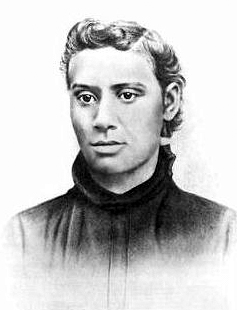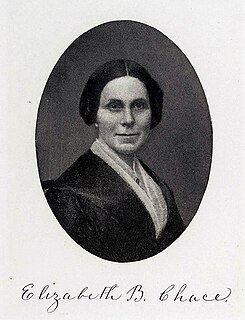Related Research Articles

Maria Louisa Bustill Robeson was a Quaker schoolteacher; the wife of the Reverend William Drew Robeson of Witherspoon Street Presbyterian Church in Princeton, New Jersey and the mother of Paul Robeson and his siblings.
Charles Hicks Bustill (c.1815–1890) was an African-American abolitionist and conductor in the Underground Railroad in Philadelphia before the American Civil War. He made a living as a plasterer.
Joseph Cassey Bustill (1822–1895) was an African American conductor in the Underground Railroad, operating primarily in Philadelphia to aid refugee slaves.

The Institute for Colored Youth was founded in 1837 in Philadelphia, Pennsylvania, United States. It became the first high school for African-Americans in the United States, although there were schools that admitted African Americans preceding it. At the time, public policy and certain statutory provisions prohibited the education of blacks in various parts of the nation and slavery was entrenched across the south. It was followed by two other black institutions— Lincoln University in Pennsylvania (1854), and Wilberforce University in Ohio (1856). The second site of the Institute for Colored Youth at Ninth and Bainbridge Streets in Philadelphia was added to the National Register of Historic Places in 1986. It is also known as the Samuel J. Randall School. A three-story, three-bay brick building was built for it in 1865, in the Italianate-style After moving to Cheyney, Pennsylvania in Delaware County, Pennsylvania its name was changed to Cheyney University.
The Clayton family is an old Quaker family that came to America with William Penn in 1682 and has been prominent politically, particularly in Pennsylvania and Delaware.

Elizabeth Buffum Chace was an American activist in the anti-slavery, women's rights, and prison reform movements of the mid-to-late 19th century.
Margaret Hope Bacon was an American Quaker historian, author and lecturer. She is primarily known for her biographies and works involving Quaker women’s history and the abolitionist movement. Her most famous book is her biography of Lucretia Mott, Valiant Friend, published in 1980.

David Bustill Bowser was a 19th-century African-American ornamental artist and portraitist.

The Philadelphia Female Anti-Slavery Society (PFASS) was founded in December 1833 and dissolved in March 1870 following the ratification of the 14th and 15th Amendments to the U.S. Constitution. It was founded by eighteen women, including Mary Ann M'Clintock, Margaretta Forten, her mother Charlotte, and Forten's sisters Sarah and Harriet.

Gertrude Emily Hicks Bustill Mossell was an African-American journalist, author, teacher, and activist. She served as the women's editor of the New York Age from 1885 to 1889, and of the Indianapolis World from 1891 to 1892. She strongly supported the development of black newspapers and advocated for more women to enter journalism.

Sarah Mapps Douglass was an American educator, abolitionist, writer, and public lecturer. Her painted images on her written letters may be the first or earliest surviving examples of signed paintings by an African-American woman. These paintings are contained within the Cassey Dickerson Album, a rare collection of 19th-century friendship letters between a group of women.

Amy Hester "Hetty" Reckless was a runaway slave who became part of the American abolitionist movement. She campaigned against slavery and was part of the Underground Railroad, operating a Philadelphia safe house. She fought against prostitution and vice, working toward improving education and skills for the black community. Through efforts including operating a women's shelter, supporting Sunday Schools and attending conferences, she became a leader in the abolitionist community. After her former master's death, she returned to New Jersey and continued working to assist escaping slaves throughout the Civil War.
Grace Bustill Douglass was an African-American abolitionist and women's rights advocate. Her family was one of the first prominent free black families in the United States. Her family's history is one of the best documented for a black family during this period, dating from 1732 until 1925.
Mary Mossell Griffin was an American writer, clubwoman, and suffragist based in Philadelphia.

Noted Negro Women: Their Triumphs and Activities is an anthology of biographies of African-American women edited by Monroe Alpheus Majors published in 1893 in Chicago. Majors sketched the lives of nearly 300 women, including Edmonia Lewis, Amanda Smith, Ida B. Wells, and Sojourner Truth. Majors began to compile the book in Waco, Texas, in 1890. He hoped to show the worth of black women for themselves and as an expression of the value of all African Americans. A significant omission from the book was Harriet Tubman. The book sought to shape contemporary attitudes and historian Milton C. Sernett hypothesizes that including Tubman would invoke memories of the pain of slavery.

This article documents the history of African-Americans or Black Philadelphians in Philadelphia.
Cyrus Bustill was an African-American brewer and baker, abolitionist and community leader.
Robert Douglass Jr. was an African-American artist and leading activist from Philadelphia.
Anna Bustill Smith was a cousin of Paul Robeson and member of Philadelphia's prominent Bustill family. A suffragist, who was the first known African-American genealogist in the United States, she also achieved recognition as an African-American author during the 20th century. Among her most important works are biographical sketches about members of the Bustill family, as well as her Reminiscences of Colored People of Princeton, N.J., 1800–1900, which was a study of Princeton's Black community that was published in 1913.
Grace A. Mapps was an American educator, administrator and poet, who was possibly the first black woman in America to graduate with a four-year college degree. Mapps graduated from New-York Central College at McGrawville in 1852, but the type of degree she received is not recorded. As such, Mary Jane Patterson is widely regarded as the first African American woman to graduate with a four-year bachelor's degree. Understandings of Mapps' achievements are also complicated by regular confusion with relatives Sarah Mapps Douglass and Grace Douglass, both of whom were prominent activists and educators.
References
- 1 2 Woodson, C.G. "The Bustill Family," in "Negro History Bulletin," Vol. 11, No. 7, pp. 147-148, p. 167. Washington, D.C.: The Association for the Study of African American Life and History (ASALH).
- ↑ Temple, Brian (2014). Philadelphia Quakers and the Antislavery Movement. McFarland. ISBN 9780786494071.